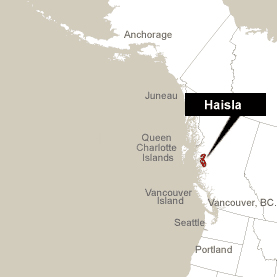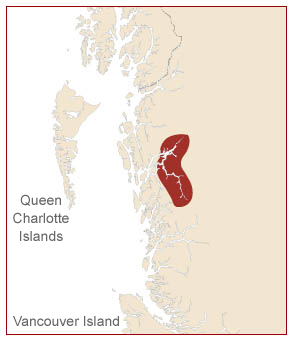
“The Haisla, meaning “dwellers downriver”, have occupied lands for over 9000 years. Today, the Haisla people are centered on Kitamaat Village. Home to about half of the 1700 Haisla, Kitamaat Village sits at the head of the Douglas Channel in British Columbia. The balance of the Haisla lives elsewhere in the region or in Greater Vancouver.
Today’s Haisla Nation is an amalgamation of two historic bands – the Kitamaat of the Douglas and Devastation channels and the Kitlope of the upper Princess Royal Channel and Gardner Canal. Neighbouring nations include the Heiltsuk and Wuikinuxv bands of the Coast Tsimshian peoples.
Living and working on the water has always been important to the Haisla, and that remains so today. The Haisla people have lived off the land and water resources of the Douglas Channel and our traditional territory for hundreds of years, and protection of those resources for future generations is a strong commitment by every Haisla member.
 Our territory’s resources have sustained us for generations, providing us with food, shelter, and livelihood. We have worked hard to harvest food, build our villages, and develop the resources we need to survive. The land is connected to our past, our culture, and now, our future.
Our territory’s resources have sustained us for generations, providing us with food, shelter, and livelihood. We have worked hard to harvest food, build our villages, and develop the resources we need to survive. The land is connected to our past, our culture, and now, our future.
The Haisla social system is based on matrilineal clans. Eight clans (Eagle, Beaver, Crow, Killer Whale, Wolf, Frog, Raven, and Salmon) make up the community, each clan with its own chief, resources area, and winter village.
Most Haisla continue to carry on the traditions of hunting, berry picking, gathering and fishing. Every spring, Haisla family groups still travel to the Kemano River for oolichan fishing. At this time, the village is full of the rich smell of the fish smoking. After a long, hard North Coast winter, oolichan are the first fish returning to spawn in local rivers. The Haisla use oolichan for almost everything, from food to medicine. Haisla people learned to boil oolichan and make it into a pure white grease, becoming experts producing a quality well known up and down BC’s Coast. Haisla people still trade this valuable commodity with neighbouring villages.
The Haisla language is spoken by the descendants of the Gitamaat and Kitlope bands from the Kitimat area of the northern coast of British Columbia. Haisla is one of the Wakashan tongues, related closely to Kwak’wala (previously called Kwakiutl) and Heiltsuk (Bellabella) and more distantly to the Nuuchahnulth (Nootka), Nitinat and Makah. The Wakashan Language Family is one of the six language families of the northern Northwest Coast cultural area.
Haisla names and words are written in a phonetic alphabet developed to allow the sounds of the Haisla language to be distinguished. Several different scientifically accurate alphabets have been used for writing Haisla. We use a transcription system based on a Haisla alphabet devised by Emmon Bach.
The Haisla people have occupied lands for over 9000 years. For hundreds of years the Haisla people have occupied many village sites throughout their territory.
In 1918, an influenza pandemic dramatically reduced the Haisla population and wiped out the Wolf and Frog clans. The Haisla community recovered and continues to evolve. Today, there are about 1700 Haisla, half of which live in Kitamaat Village.
Though clan distinctions and connections remain today, Haisla culture combines traditional heritage with Canadian culture. The Na’Na’Kila Institute was established in 1998 to help protect and encourage development of Haisla culture, including language.
Na’Na’Kila helped bring about the repatriation of a Haisla totem pole that had been removed in 1929 and was missing for more than 60 years. It was discovered in the Museum of Ethnography in Stockholm in 1991 and, after years of negotiation, it was returned to Kitamaat on July 1, 2006. In exchange for it’s safe return, the Haisla carved a replica pole to gift to the museum in Stockholm.”
Source: Text Copyright of the Haisla Nation webpage
